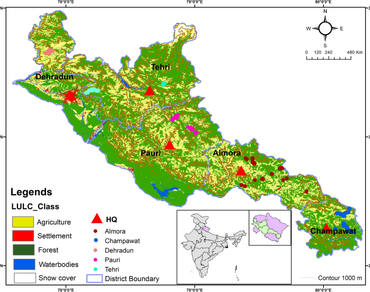Contouring of an indistinct sex ratio and COVID-19 threat to the sustainability of Myrica esculenta in the Northwestern Himalayas
*Article not assigned to an issue yet
Panwar Smriti, Chandra Girish, Ginwal Harish S., Pandey Shailesh, Meena Rajendra K., Bhandari Maneesh S.
Research Articles | Published: 13 August, 2024
First Page: 0
Last Page: 0
Views: 1992
Keywords: n Myrica esculentan , Sex ratio, Generalized linear model, Variance estimation, Abiotic factors, Northwestern Himalayan landscape
Abstract
COVID-19 has dramatically affected every landscape on Earth, and the Indian Himalayan Region (IHR) forest biodiversity is also affected by the local inhabitants and immigrants during the pandemic scenario, as they are still dependent upon the procurement of raw materials for their socio-economic upliftment. The research aimed to determine the indeterminate sex ratios in M. esculenta by implying a stratified random sampling procedure with proportional allocation. Forest surveys were conducted during 2018–2020 and quadrats (each with an area of 400 m2) were laid in various forest strata across the northwestern Himalayas (Uttarakhand, India). The anthropogenic stress encountered by this species was also observed and analysed to reveal the threats obstructing its perpetuity. To analyse and assess the impact of human intervention on the female trees of M. esculenta, a General Linear Model (GLM) was applied. Results revealed a ratio of 1.45 (Male:Female) was obtained, indicating the prevalence of a male-dominant population of M. esculenta across the northwestern Himalayas. The ANOVA (p = 0.008) suggested magnified anthropogenic stress upon females (average damage on female trees per 400 m2 ((widehat{Y})) = 0.64 ± 0.751) in 2020, where the estimator revealed an overall damage of 50.02% in the surveyed areas. The study provides a scenario defining the detrimental impact of lockdown on species-specific diversity levels in the Himalayas. It also suggests that managing and unearthing the sex ratio of already depleting resources is the key step for in situ and ex situ conservation programmes in M. esculenta.

References
Barrett SCH, Yakimowski SB, Field DL, Pickup M (2010) Ecological genetics of sex ratios in plant populations. Phil Trans R Soc Lond B: Biol Sci 365(1552):2549–2557. https://doi.org/10.1098/rstb.2010.0002
Bhandari MS, Shankhwar R, Meena RK et al (2020) Past and future distribution pattern of Myrica esculenta in response to climate change scenario. Model Earth Syst Environ. https://doi.org/10.1007/s40808-020-00902-x
Daly DC (2020) We have been in lockdown, but deforestation has not. Proc Natl Acad Sci USA 117(40):24609–24611. https://doi.org/10.1073/pnas.2018489117
Delph LF (1999) Sexual dimorphism in life history. In: Geber MA, Dawson TE, Delph LF (eds) Gender and sexual dimorphism in flowering plants. Springer, Berlin
Edwards AW (2000) Carl Düsing (1884) on the regulation of the sex-ratio. Theor Popul Biol 58(3):255–257. https://doi.org/10.1006/tpbi.2000.1482
Grant MC, Mitton JB (1979) Elevational gradients in adult sex ratios and sexual differentiation in vegetative growth rates of Populus tremuloides Michx. Evolution 33(3):914–918. https://doi.org/10.1111/j.15585646.1979.tb04744.x
Gupta B, Mehta R, Mishra VK (2009) Fire ecology of ground vegetation in Pinus roxburghii sargent plantations in North-West Himalaya—floristic composition and species diversity. Casp J Environ Sci 7(2):71–78
Gupta A, Bhatt CM, Roy A, Chauhan P (2020) COVID-19 lockdown a window of opportunity to understand the role of human activity on forest fire incidences in the Western Himalaya India. Curr Sci 119(2):390–398
Husen A (2013) Growth characteristics, biomass and chlorophyll fluorescence variation of Garhwal Himalaya’s fodder and fuel wood tree species at the nursery stage. Open J for 3:12–16. https://doi.org/10.4236/ojf.2013.31003
Jeeva S, Lyndem FG, Sawian JT, Laloo RC (2011) Myrica esculenta Buch- Ham. ex. D. Don.—a potential ethnomedicinal species in a subtropical forest of Meghalaya, northeast India. Asian Pac J Trop Biomed. https://doi.org/10.1016/S2221-1691(11)60150-0
Khanduri VP, Sukumaran A, Sharma CM (2019) Male-skewed sex ratio in Myrica esculenta: a dioecious tree species. Trees. https://doi.org/10.1007/s00468-019-01850-5
Lloyd DG, Webb CJ (1997) Secondary sex characters in plants. Bot Rev 43(2):177–216
Muralidar S, Ambi SV, Sekaran S, Krishnan UM (2020) The emergence of COVID-19 as a global pandemic: understanding the epidemiology, immune response and potential therapeutic targets of SARS-CoV-2. Biochimie 179:85–100. https://doi.org/10.1016/j.biochi.2020.09.018
Negi V, Maikhuri R, Rawat L, Chandra A (2013) Bioprospecting of Rhododendron arboreum for livelihood enhancement in Central Himalaya, India. Int J Sci Technol 8:61–70
Randler C, Tryjanowski P, Jokimäki J, Kaisanlahti-Jokimäki ML, Staller N (2020) SARS-CoV2 (COVID-pandemic lockdown influences nature-based recreational activity: the case of birders. Int J Environ Res Public Health 17(19):7310. https://doi.org/10.3390/ijerph17197310
Shankhwar R, Bhandari MS, Meena RK et al (2019) Potential eco-distribution mapping of Myrica esculenta in northwestern Himalayas. Ecol Eng 128:98–111. https://doi.org/10.1016/j.ecoleng.2019.01.003
IHD (2019) Institute for human development. Uttarakhand human development Report 2019. Department of planning, government of Uttarakhand, Dehradun.
ISFR (2019) India State of Forest Report, Forest Survey of India. Ministry of environment & forest and climate change, Dehradun, India.
Kumar A (2020) Corona virus: Pandemic brings Uttarakhand’s ghost hamlets to life. The Hindu. https://www.thehindu.com/news/national/coronavirus-pandemic-brings-uttarakhands-ghost-hamlets -to-life/ article31608989.ece. Accessed 9 Nov 2020
PTI (2020) Lockdown in India has impacted 40 million internal migrants: world bank. The Hindu. https://www.thehindu.com/news/international/lockdown-in-india-has-impacted-40-million-internal-migrants-worldbank/article31411618.ece. Accessed 15 Oct 2020)
Rural Development and migration commission of Uttarakhand (2020) http://www.uttarakhandpalayanayog.com/. Accessed 20 Oct 2020
Author Information
Division of Genetics & Tree Improvement, ICFRE-Forest Research Institute, Dehradun, India